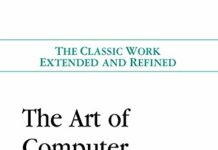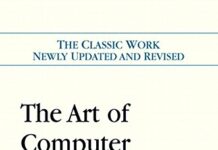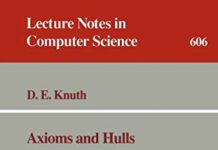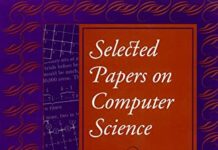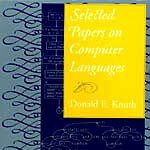
Ebook Info
- Published: 2011
- Number of pages: 496 pages
- Format: PDF
- File Size: 2.24 MB
- Authors: Donald E. Knuth
Description
This is the definitive and complete user manual to the TeX computerized typesetting system. TeX software offers both writers and publishers the opportunity to produce technical text, with the speed and efficiency of a computer system.
User’s Reviews
Editorial Reviews: From the Back Cover Here is the definitive guide to the use of TeX, written by the system’s creator, Donald E. Knuth.TeX represents the state of the art in computer typesetting. It is particularly valuable where the document, article, or book to be produced contains a lot of mathematics, and where the user is concerned about typographic quality. TeX software offers both writers and publishers the opportunity to produce technical text of all kinds, in an attractive form, with the speed and efficiency of a computer system.Novice and expert users alike will gain from The TeXbook the level of information they seek. Knuth warns newcomers away from the more difficult areas, while he entices experienced users with new challenges. The novice need not learn much about TeX to prepare a simple manuscript with it. But for the preparation of more complex documents, The TeXbook contains all the detail required.Knuth’s familiar wit, and illustrations specially drawn by Duane Bibby, add a light touch to an unusually readable software manual.The TeXbook is the first in a five-volume series on Computers and Typesetting , all authored by Knuth. 0201134489B04262002 About the Author Donald E. Knuth is known throughout the world for his pioneering work on algorithms and programming techniques, for his invention of the Tex and Metafont systems for computer typesetting, and for his prolific and influential writing. Professor Emeritus of The Art of Computer Programming at Stanford University, he currently devotes full time to the completion of these fascicles and the seven volumes to which they belong.
Reviews from Amazon users which were colected at the time this book was published on the website:
⭐This book has been helpful in extending my ability to effectively typeset documents with TeX and LaTeX. This is especially true as I move away from basic concepts and need to establish assorted styles.
⭐I bought the TeXbook two years ago, but finally spent a few days reading it cover to cover — and I am impressed. As many others, I started exploring plain TeX because I wanted more from LaTeX. I was surprised to find how simple and, yes, *elegant* TeX is in comparison. I guess TeX is to LaTeX as C is to C++. Certainly do not buy this book if you just want to use LaTeX!The writing is superb, full of fine detail and more than a few clever jokes. Why can’t recent books about modern systems be so delightful? Maybe David Pogue’s Missing Manual series comes close, but the topics are not quite as technical.As a reference, the TeXbook is weak because each command or concept is scattered across so many places: one introductory chapter, one summary chapter, in exercises, in “dangerous bend” passages, and so on. I believe the book is best organized for front to back reading, although probably in two or three passes if you include the dangerous bends. For reference, I prefer TeX by Topic by Victor Eijkhout. It is out of print, but available for download on his web site.The paperback edition of the TeXbook is spiral bound. I appreciate that it lays flat, but the back pages are always falling out of the binding!
⭐TeX gives all you need to set up technical and non-technical documents, and this book has it.
⭐The book is great for learning TeX—but are you using TeX now? Chances are (if you’re reading this), you’re a LaTeX user. My sole objection to giving this five stars is its age (no offense intended): with the current standards, some of its suggestions and pointers no longer apply.I readily stand by my four star rating: it teaches the reader about primitives, units, etc. However, one may ask “Who starts a new page with vfilleject when newpage is way to go now?” However, if you want to know the answer to the follow-up question “Why is newpage the way to go now?”, then this book is for you. This is not for someone looking to learn how to typeset in LaTeX (as of this writing, the current standard). It is intended for someone who wants a better understanding of the foundations of LaTeX.
⭐Ordered spiral bound version, got softcover printing version. At least it’s the 2017 revised version, bound recently in June 2021.Paper/printing quality is a little low; it feels like low DPI inkjet printers.
⭐While this book is fairly detailed, and covers the method TeX processes lines completely, it is for the most part poorly organized. It seems to be intended more as a tutorial than as a reference.The more advanced methods are interspersed in an almost haphazard way with the beginning techniques. Simple typesetting problems like creating multiple columns, changing margins, and using a different font size are covered very obliquely, and it takes multiple readings to figure out how to do such things.However, the section on creating mathematical equations is very well done, and I was soon able to master very complicated formatting. The book also talks about “proper” typesetting–the three different dashes and when to use them, the difference between spacing after an abreviation and a sentence-ending period, etc. I only wish Knuth had included all those great tidbits in a table somewhere–sometimes it can take quite a long time to hunt down the information.TeX is a wonderful typestting language that is great for anything from math reports to psychology research papers, to book typesetting. Unfortunately this book does a poor job of explaining the language, and is not a good reference for someone who is familiar with it.
⭐This is a must have if you are a serious TeX/LaTeX user. Knuth, the creator of TeX, discusses the concepts (eg. boxes and glue) and algorithms (line breaking, page breaking, spacing in equations) underlying the program and discusses tips, tricks and pitfalls.Even if you have no wish to poke into TeX’s internals, the TeXbook is worth reading as a masterpiece of technical writing. Knuth asks you to solve exercises and tackle difficult passages marked with “dangerous bend” signs. He rewards you with witty epigraphs and in-jokes. (Regarding the pronunciation of TeX: “When you say it correctly to your computer, the terminal may become slightly moist”). Realizing how much thought Knuth has put into the design of TeX will make it harder for you to cut corners the next time you start a creative project. Among programming books I have read, only
⭐has helped me more in improving myself intellectually.
⭐Always expect a good read from Knuth. Entirely practical and esoteric at the same time. A wonderful addition to anyone’s library. Well worth the money.
⭐When we first got WYSIWYG and desktop publishing people would say “Anyone can do it” and leave out the last word, “badly”.The primary limitation of this book is that it tells you how to use a (brilliant) program to typeset documents. In that sense it is a very good piece of work. The writing is clear, concise and humorous. The author is self evidently an expert in three fields (typesetting, coding and explaining). He leads you through many areas of deep knowledge so you know the how and why of what you’re doing. And if you work through all the exercises, you will be good at what you do. Unmatched actually.Implicit in this is the readers have an eye for beauty (this is about producing beautiful, readable text after all), but how many people do? Knuth tells us everything we need to know about how to spot beautiful typesetting, but this is a different skill, and I know from experience that a badly laid out TeX document is as bad as any MS Word document.So this book wont give you that skill. If you don’t have the eye, you’ll be competent, not exceptional (but TeX has good defaults, so it may not effect you).But the book has other levels. If you find yourself having to develop a Domain Specific Language then TeX is the primary example of a big DSL and the disciplin needed. It demonstrates many principles, but the key one is that you can’t just capture a process and throw code at it. An excellent result needs both knowledge of how to code, why to code and what to code.The third level is that this is a manual that demonstrates very clearly what a manual can be like. The dry-as-dust appraoch you see in many vendors manuals makes them difficult to read, provide skills without insight, and re-create the a world where ‘Anyone can do it, badly’.So, 5 stars.
⭐Whilst I do not like the idea of spiral binding, the quality of the original version ( that I borrowed from our library) looks and feels premium. This version, however, is not spiral bound but a cheap glue binding. It feels like a draft PhD thesis printed on photocopy paper and soft bound. I have already returned it and will buy the hard cover version somewhere else.
⭐I found this book enormously helpful. Written by the creator of TeX, it provides an actual understanding of TeX, how it works, and why it does things the way it does. That said, it may not be for everyone: if all you are looking for is a basic functional understanding of the program, this probably has unnecessary detail and information, particularly in the light of LyX-like programs that make the actual commands somewhat less useful.Even so, I would highly recommend the book to anyone starting to use TeX. The book is not a list of commands, and should not be bought as such, but instead provides a much more broad understanding of the program, useful for when you encounter a non-obvious problem or want to go beyond the basic commands.
⭐I feel cheated, outraged and upset. This book is bound with concentric circles, not the seductively curving helix I was expecting. This is the first and dammit shall be the last time I buy a book by Donald E. Knuth.
⭐All arrived in a perfect state. Recommended
Keywords
Free Download TeXbook, The in PDF format
TeXbook, The PDF Free Download
Download TeXbook, The 2011 PDF Free
TeXbook, The 2011 PDF Free Download
Download TeXbook, The PDF
Free Download Ebook TeXbook, The
